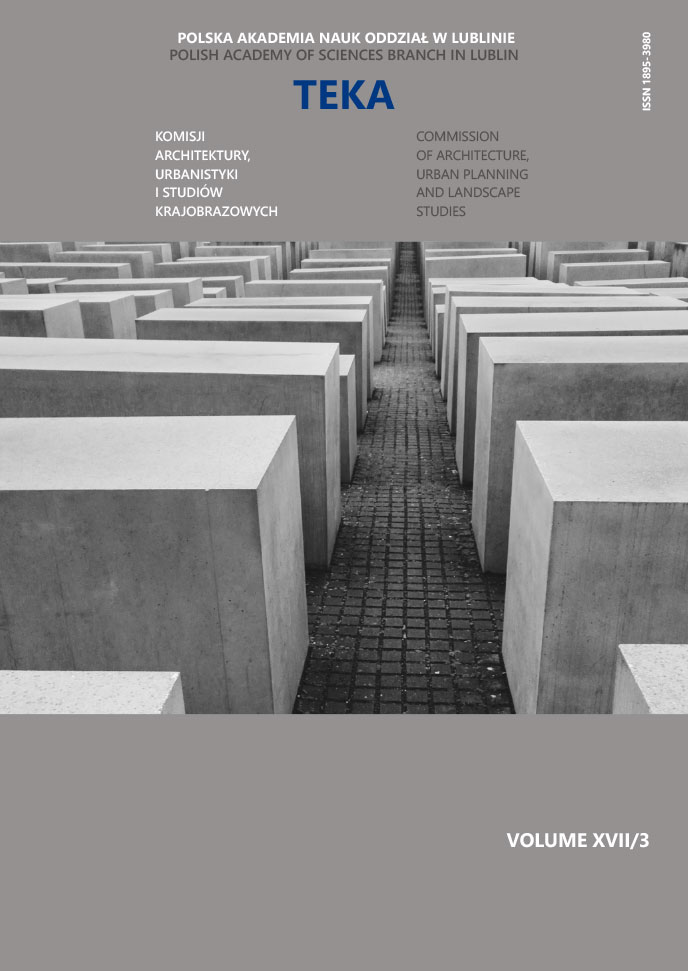Factors shaping the Venice Charter and its usefulness – on the example of heritage protection in Poland
Article Sidebar
Open full text
Issue Vol. 17 No. 3 (2021)
-
The importance of heritage conservation in architectural education at university level
Krystyna Kirschke7-17
-
Spójność przestrzenna na przykładzie małej architektury w wybranych obiektach Twierdzy Przemyśl
Olga Skoczylas18-25
-
Designs of seven grade schools built as wooden structures in period 1927–1938 on Lubelszczyzna region
Ewa Miłkowska26-33
-
The idea of sustainable development in the landscape contemporary cities
Paweł Piotr Szumigała, Piotr Urbański, Przemysław Tomczak, Miłosz Walerzak, Sylwia Sosnowska, Karolina Olenia Szumigała34-54
-
Discovering layers of history. Auschwitz Jewish Center „Oshpitzin” and The Great Synagogue Memorial Park in Oświęcim
Bartosz Haduch55-62
-
Perception of form as guidelines for creating a city panorama
Karolina Sobczyńska63-69
-
Studium badawcze zabytku, w celu przystosowania budynku do parametrów niemal zero energetycznych
Wroniecka 23 w PoznaniuSławomir Rosolski, Michał Rutkowski, Jakub Wójtowicz70-83 -
Factors shaping the Venice Charter and its usefulness – on the example of heritage protection in Poland
Bogusław Szmygin, Olga Skoczylas84-90
-
Plant ornaments in the architectural detail of Art Nouveau tenement houses and villas of Jeżyce and Łazarz in Poznań
Paweł Piotr Szumigała, Przemysław Tomczak, Karolina Szumigała91-107
Archives
-
Vol. 19 No. 2
2023-12-29 11
-
Vol. 19 No. 1
2023-12-19 13
-
Vol. 18 No. 4
2022-12-30 5
-
Vol. 18 No. 3
2022-12-27 5
-
Vol. 18 No. 2
2022-12-27 5
-
Vol. 18 No. 1
2022-12-27 4
-
Vol. 17 No. 4
2021-12-30 11
-
Vol. 17 No. 3
2021-12-30 9
-
Vol. 17 No. 2
2021-12-30 8
-
Vol. 17 No. 1
2021-12-30 8
-
Vol. 16 No. 4
2020-12-30 11
-
Vol. 16 No. 3
2020-09-30 10
-
Vol. 16 No. 2
2020-06-30 11
-
Vol. 16 No. 1
2020-03-31 10
-
Vol. 15 No. 4
2019-12-30 6
-
Vol. 15 No. 3
2019-10-31 9
-
Vol. 15 No. 2
2019-06-28 12
-
Vol. 15 No. 1
2019-03-29 13
Main Article Content
DOI
Authors
Abstract
In the collection of dozens of doctrinal documents on the protection of heritage, the Venice Charter occupies a unique position. The Venice Charter was created more than half a century ago, but it is still treated as the universal, basic document of the heritage protection. This is confirmed by numerous declarations emphasizing the validity of the Venice Charter, contained in many doctrinal documents adopted by ICOMOS, and even in the Operational Guidelines of the UNESCO World Heritage Committee. The Venice Charter is therefore a kind of decalogue for the monument protection [1]. However, every few years there are discussions whether Venice Charter still retains this position. This problem is not resolved unequivocally.
However, in the twenty-first century, it can be stated that Venice Charter is not an universal document and cannot be a document shaping the entire heritage protection. This is shown by the reception of the Venice Charter by the Polish conservation community over the past decades. The change of the Venice Charter position is particularly clear in the context of the system transformation that took place as a result of the fall of communism in 1989. This change shows well that doctrinal documents of the heritage protection reflect the external conditions in which they are created. Their importance and usefulness is in principle limited to specific conditions and a specific group of heritage. This is also how the Venice Charter should be treated.
Keywords:
References
Jeleński T., Practices of Built Heritage Post-Disaster Reconstruction for Resilient Cities, Buildings, t. 8, nr 4, Art. nr 4, kwi. 2018, doi: 10.3390/buildings8040053. DOI: https://doi.org/10.3390/buildings8040053
Zhiwen H., The Venice Charter: International Charter for the Conservation and Restoration of Monuments and Sites (1964), sty. 17, 2016, http://orcp.hustoj.com/venice-charter-1964/ (dostęp grudz. 21, 2021).
Pabijan M., Palomar García G., Flores Antunes B., Antoł W., Zieliński P., Babik W., Evolutionary principles guiding amphibian conservation, Evol. Appl., t. 13, nr 5, 2020, doi: 10.1111/eva.12940. DOI: https://doi.org/10.1111/eva.12940
Fuglewicz S., System służb ochrony zabytków w Polsce a społeczna partycypacja w ochronie zabytków, Prot. Cult. Herit., nr 1, Art. nr 1, maj 2016, doi: 10.24358/ODK_2016_01_05. DOI: https://doi.org/10.24358/ODK_2016_01_05
Gyurkovich M., Gyurkovich J., New Housing Complexes in Post-Industrial Areas in City Centres in Poland Versus Cultural and Natural Heritage Protection—With a Particular Focus on Cracow, Sustainability, t. 13, nr 1, Art. nr 1, sty. 2021, doi: 10.3390/su13010418. DOI: https://doi.org/10.3390/su13010418
Pielas M., To learn – to value – to protect. The role of documenting cultural heritage in the construction of social support for the idea of the protection of historical monuments, Muzealnictwo, t. 47, s. 129−135, 2006.
Huang J., Obracht-Prondzynska H., Kamrowska-Zaluska D., Sun Y., Li L., The image of the City on social media: A comparative study using “Big Data” and “Small Data” methods in the Tri-City Region in Poland, Landsc. Urban Plan., t. 206, s. 103977, luty 2021, doi: 10.1016/j.landurbplan.2020.103977. DOI: https://doi.org/10.1016/j.landurbplan.2020.103977
Forrest C., International Law and the Protection of Cultural Heritage. London: Routledge, 2009. doi: 10.4324/9780203865194. DOI: https://doi.org/10.4324/9780203865194
Merryman J.H., Protection of the Cultural Heritage, Am. J. Comp. Law Suppl., t. 38, s. 513, 1990. DOI: https://doi.org/10.2307/840556
Ferretti V., Bottero M., Mondini G., Decision making and cultural heritage: An application of the Multi-Attribute Value Theory for the reuse of historical buildings, J. Cult. Herit., t. 15, nr 6, s. 644−655, lis. 2014, doi: 10.1016/j.culher.2013.12.007. DOI: https://doi.org/10.1016/j.culher.2013.12.007
Article Details
Abstract views: 320
License

This work is licensed under a Creative Commons Attribution-ShareAlike 4.0 International License.


